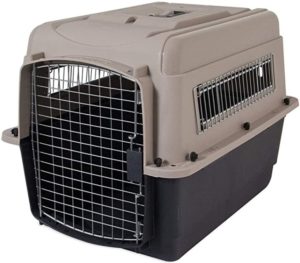How Do I Acclimate My Puppy Or Dog To A Crate?
Now that you have decided that crating is a brilliant idea, how do you convince your puppy? And if your dog is already grown, is it too late? Although dogs of any age can learn to see the crate as their safe haven, most will need a little persuasion. First, consider the crate’s location. Your pet is a part of your family and should ideally have his “den” in a social area such as the living room or family room. A second crate in your bedroom (or one that you can easily carry back and forth) can make nights much more peaceful, and less lonely, for both of you.
Once you’ve found a suitable corner for the crate, line it with a soft blanket and leave the door wide open for investigation. Place a special food treat and a few toys inside, and wait for your puppy to discover the bounty, so that he freely comes and goes without anxiety. When he appears comfortable with going in and coming out, introduce a word such as “kennel!” as he enters, and offer yet another food reward — before he exits. With some luck, your puppy may even choose to take a nap on that soft blanket. While he naps or chews on a toy, begin to close the door for short periods, opening it again without fanfare. Remember to reward him for entering, but not for leaving, the crate, and use your cue word as often as possible. You’ll soon find that you can keep the door closed for longer periods.
Crates should be used with some frequency, and at random times while you are at home. It is best, at first, to avoid leaving the puppy alone. Imagine her anxiety if, the first or second time the crate is latched, she watches you leave through the door and then waits hours for your return. Instead, be as low-key as possible while you tell her to “kennel”, reward her, shut the door for short (and then gradually longer) periods with little excitement, and stay nearby. After a few days of this acclimation, she is likely to ignore your departure to other rooms or even out of the house — and is much less likely to develop separation anxiety in the future.
Adult dogs can be acclimated similarly, but with a few caveats. If your dog has any history of separation anxiety — or anxiety of any kind — crating may aggravate the problem. It may still be possible, but you might want to ask yourself the reason. Crating is not a solution for destructiveness or bathroom accidents if they are caused by distress. If your pet has been chewing on the couch or urinating in your absence, a better solution would be to address that anxiety with the help of a veterinarian or behavioral specialist. For other dogs, any barrier at all — whether a shut door or a crate — is a source of frustration and distress. In the absence of anxiety or barrier frustration, however, the crate can be a safe — and portable — shelter for your four-legged companion.
Ed. Note: There is a great video on YouTube that shows how one family crate-trained their Samoyeds. Click Here.

